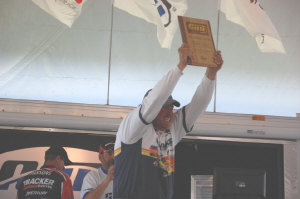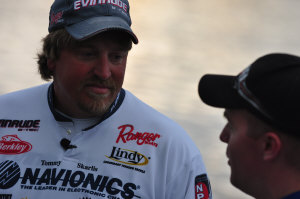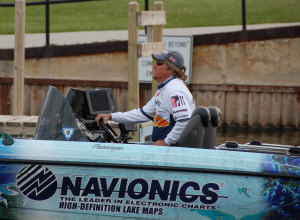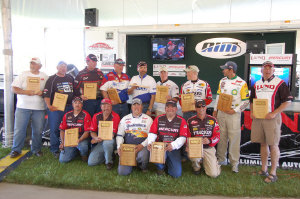Tommy Skarlis Wins AIM Pro Walleye Series Tournament in Dramatic Come From Behind Victory
Category: article
Jun 2nd, 2009 by OutdoorsFIRST
Modified Jun 2nd, 2009 at 12:00 AM
Veteran walleye pro Tommy Skarlis jigged and trolled his way to yet another fishing milestone May 22-24 at Bay City, Michigan, winning the first-ever Anglers Insight Marketing (AIM) Pro Walleye Series tournament.
 |
|
|
Skarlis Hoists the First Place Trophy
|
The victory was a big moment in Skarlis’ career. “It ranks right up there with winning my first Professional Walleye Trail (PWT) event, the Masters Walleye Circuit Team of the Year, PWT Angler of the Year-and almost with winning the FLW Walleye Tour Championship last fall,” he said. “I give credit to God, my equipment, and my co-anglers.”
AIM’s innovative Catch-Record-Release format allowed anglers to compete without ever weighing a fish. Their catches were measured, photographed and released; the length of each angler’s seven largest fish for each day was converted into pounds and ounces using a standardized formula. In the end, Skarlis tallied 479.25 inches during the three-day event, good for 100.93 pounds and a $27,000 payday-1.21 pounds ahead of Gary Parsons.
Skarlis credits a variety of gear for propelling him to victory on the walleye-rich Saginaw Bay system, which offered competitors varied fishing options ranging from big-water trolling on the bay to picking apart structure in the river.
Pre-fishing Strategy
During pre-fishing, Skarlis explored a number of locations and patterns, hoping to compile a milk run of spots that would withstand weather changes and fishing pressure. “Saginaw Bay is full of walleyes,” he says. “The problem is, most of them are the same size-18 to 23 inches. There are bigger fish, of course, and there’s always the fear of them coming into play. But still, going into pre-fishing, I believed it would take 7 fish a day averaging 23 inches to be in the hunt.”
With AIM’s conversion formula that’s roughly 30 pounds a day. Skarlis knew he’d need to handle big numbers of fish to reach that average, and the best way to accomplish that would be trolling. Putting together a bulletproof trolling program on Saginaw Bay is easier said than done, however. The massive open-water fishing grounds are subject to the whims of nature. Strong winds can wreak havoc on the best-laid plans, muddying the waters and making prime lies unfishable.
“I was fortunate to figure out a pattern early in pre-fishing that would produce walleyes throughout the event,” Skarlis said. “When the wind took a lot of spots I wanted to fish out of play, I focused on protected areas just outside the Saginaw River mouth.”
His go-to spots were flats with 6-foot contours. Though most of his competitors were targeting deeper water, in the 12- to 17-foot range, Skarlis correctly assessed that the walleyes’ offshore post-spawn migration was running late. “The fish were a little behind where they were a year ago during the PWT Championship,” he said. That event was won offshore, trolling spinner rigs in 14 feet of water on the Callahan Reef area, although Skarlis placed second on the wings of a strong finish in the Saginaw River.
 |
|
|
Day Two AIM Interview
|
At the AIM event, Skarlis relied on new cartography from Navionics, which details Saginaw’s structure in 1-foot increments. “It’s phenomenally accurate,” he said. “Once the key fish-holding contours with emerging weed growth were identified, I could not only repeatedly troll through these areas with ease, but with the use of Navionics cartography, I identified numerous other areas on the bay that matched the pattern. I was confident that unless we had a strong north-northwest wind, I’d have at least one place that would be clean and fishable.”
With a trolling pattern dialed in, Skarlis turned to the Saginaw River, where he made a strong showing on Day 3 of the PWT Championship in 2008 jigging Lindy TechniGlow Max Gap jigheads tipped with Berkley Gulp! Alive! Minnows. “I believed that finding areas in the river where a guy could possibly catch bigger fish was going to be another key to winning the AIM tournament,” he said.
Unfortunately, when Skarlis checked his productive spots from 2008, the fish were gone. “So I focused on the last 2 to 3 miles down to the river mouth,” he noted. There, he found ample numbers of walleyes, along with a profusion of non-target species such as channel catfish, freshwater drum, and various suckers. “Lindy’s Fish Handling Glove saved my life,” he laughed. “I was handing over 100 fish a day.”
One of Skarlis’ key areas was near the Consumers Energy power plant. “Due to Homeland Security regulations, you have to stay 100 feet away from the plant,” he noted, “so I used a laser rangefinder to determine the areas I could fish.”
Tactical Considerations
Several tactical patterns emerged while Skarlis homed in on his key main-bay and river locations. His trolling program hinged on Lindy Old Guide’s Secret spinners with 3-hook nightcrawler harnesses hand-tied with wickedly sharp, size 2 Daiichi hooks. “Indiana blades in gold, silver, and perch were the best producers,” he noted. “I slow-trolled the rigs1.1 to 1.4 mph (1.2 to 1.3 was key) behind a 1/4-ounce split shot.”
Along with these key components, Skarlis says his OR12 Off-Shore Planer Boards and 36-volt 101EM Minn Kota Engine Mount electric trolling motor were keys to pulling off the shallow trolling program.
“I’m not one of the expert board fisherman guys like John Kolinski are,” Skarlis admits. “So the emerging weeds and light-biting walleyes made the boards’ Tattle Flags absolutely critical. They let me know if I had a weed hooked on like a hula skirt, fouling the blade, or if a fish was biting.”
With the flag’s tension properly adjusted, Skarlis was able to discern the difference between the spinner ticking weeds and walleye bites. “The flag would bounce up and down as the rig went through the weeds, but if it bounced and wiggled, you had a fish,” he explained. “You could also tell aggressive strikes from light bites, and react accordingly. When the flag popped back, a fish had sucked in the harness and I could set the hook and reel it in. But, when a fish pulled it back slowly, I had to feed the board back with my reel in free spool before setting. You had to be able to read what the walleyes wanted or you’d miss a lot of fish.”
As for his engine-mount Minn Kota, Skarlis says, “Because it’s so much quieter than a gas-powered kicker, it allowed me to run really short lines without spooking the fish in the shallow water. The distance from rod to board was just 20 feet on the inside line and 40 feet on the outside. Such short letbacks were the key to quickly reeling in and handling as many fish as possible each day. If I could pick up 20 minutes on my competitors, my average fish size was going to be that much better.” Skarlis noted that his Blue Top Group 31 Optima batteries yielded more power longer that traditional deep-cycle lead-acid batteries, yet another key to his successful trolling system.
In the river, Skarlis settled on Lindy X-Change jigs tipped with Berkley Gulp! Alive! Minnows, which he vertically jigged in 8- to 12-foot depths along the main channel. Quarter-ouncers got the nod in 9 feet of water or less; 3/8-ounce jigs were reserved for deeper water. “Little flat shelves, maybe three to four feet wide, that had been left during the dredging process were spots on the spot,” he noted. “I had my eyes glued to my electronics the whole time, because if the boat moved even a little bit out of position, you were either in three feet or 20 feet, too shallow or too deep.”
 |
|
|
Tommy Launches on Day Three
|
The walleyes didn’t fall for an overly aggressive jig stroke in the river’s modest current. “A steady lift-drop that touched bottom on the drop was best, with a hold and glide thrown in every once in awhile,” Skarlis explained. “The fish would charge in and throttle the jig-KACHOW!! The hits felt like freight trains on the sensitive, low-stretch, hi-vis 10-pound FireLine and Spiderwire Stealth I was fishing.”
Tournament Action
With prefishing plans well in hand, Skarlis entered the competition with all guns blazing. “On Day One I started out trolling crank baits in the river, but that didn’t seem to be happening so I changed gears. On the way out to my trolling spots I stopped at the main-channel shelves. I love vertical jigging and believed a couple of the channel edges could produce a 24- to 25-inch anchor fish.”
“The first jigging spot quickly gave up 24 and 22.5 inchers, but then dried up. So I stopped at another area and thank God I did. I caught six legal fish up to 26.5 inches. That was monumental. I ended up in the lead with 168.75 inches for 39.94 pounds.”
One of the first anglers out of the gate on Day Two, Skarlis headed straight for his river hotspots. “I wanted to let the other guys know I was going to protect my LZ,” he quipped. “I caught three fish within 10 minutes but then the bite died, so I rolled out to the main bay and trolled six feet of water to fill out the rest of my fish.” The strategy yielded a decent 153.5 inches for 29.40 pounds, but Gary Parsons vaulted into first with a monstrous 43.05-pound bag, taken in the river a long cast from the launch site.
“I did well in the river, but I obviously missed a lot of fish right by the ramp that Parsons found,” Skarlis said. “I give him a lot of credit for that.” Still, Skarlis didn’t despair at the setback. “It took a lot of pressure off me when Gary moved into first place,” he said. “And I knew that three of my four PWT wins came when I was fishing for second.”
True to form, Skarlis opened the final day on the river. “My partner and I jigged up five beauties from 21 to 23 inches in the first hour,” he said. “Then it became a battle to get our remaining two fish.”
With the jigging pattern evaporating, Skarlis moved out to the bay, where he discovered the wind had muddied up his first trolling area. “We tried a secondary spot, and while setting out the first line I felt weight before I even snapped on the planer board. It was a 23.5 inch walleye-the biggest fish of the day.” After missing two fish that hit in the same manner, Skarlis picked up a 14-incher that filled out his 7-fish limit. Shortly after, a 23-inch walleye upgraded his daily total to 157 inches and sealed the victory.
At the final weigh-in, his tournament total of 479.25 inches translated into 100.93 pounds. The mark easily held until Gary Parsons-the last competitor to weigh-took the stage. The crowd held its breath until Parsons’ total flashed on the display and emcee Keith Kavajecz announced that Skarlis had taken the event by 1.21 pounds.
 |
|
|
|
“It was a big win,” Skarlis beamed. “It puts me in a pretty elite category of anglers, with Gary Parsons and Ron Seelhoff, who have won six majors. This is my sixth major, and I’m very proud to be in this category of fishermen.”
He was also quick to credit his boat-mates. “I drew three incredible co-anglers with Witold Niemiec on day one, Mike Ignat on day two and Todd Schryer on day three!” he said. “That’s what’s so awesome about the co-angler format of AIM and the FLW, it gives you the opportunity to fish with a variety of great anglers and make some tremendous friends, some that last a lifetime!”